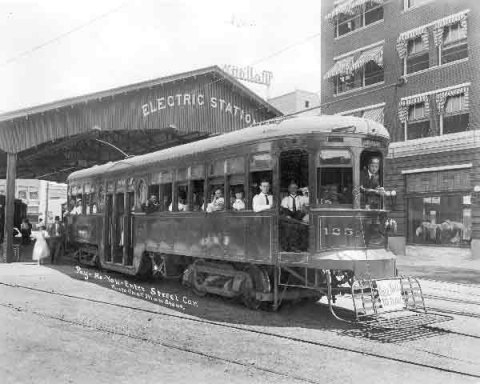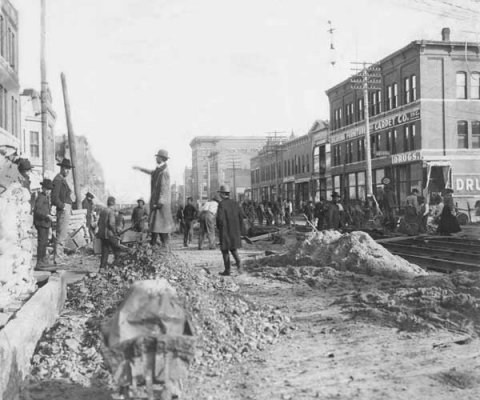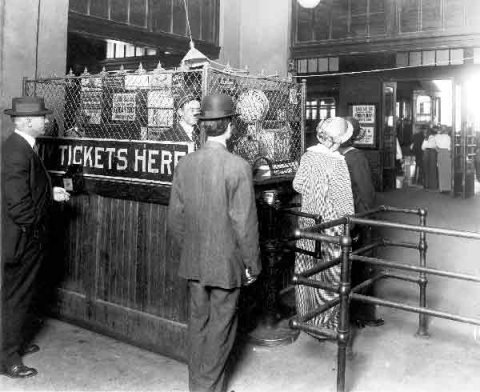Description:

Oklahoma City first heard the clang-clang-clang of the trolley on February 1, 1903. It was a Sunday afternoon and the year-old Metropolitan Railway Company (MRC) was offering free rides to the curious and excited residents of Oklahoma City. Thousands thronged the young city’s streets to witness the electrified carriages glide up and down Broadway. The free rides would continue for the next month as streetcar operators worked out the kinks in the new urban transit system.
New streetcar lines pierced the prairie landscape better than any disc plow and laid the framework for Oklahoma City’s expansion beyond the dense urban center it had become. About this time the initial Land Run boom had subsided so severely that many wondered if the teenaged town would survive to see the new century. City leaders soon rallied and a wave of boosterism swelled the dusty streets. Boosters dubbed Oklahoma City the “Industrial Prodigy of the Southwest” and traveled the country in attempts to bring new industry and capital to the city.
At this time Oklahoma City was a town of about 14,000 people crowded into about four square miles – bounded by Western Ave. on the west, Eastern Ave. on the east, Thirteenth St. on the north and the river on the south. Conditions were difficult in the dense urban area as horses and wagons became entangled at major intersections and pedestrians dodged dust, mud and manure on the streets. Development was determined by how far citizens could or were willing to walk to their destinations. Though laid out on a vast prairie, Oklahoma City might well have been an island.
Many cities were turning to electrification to solve these problems. In the large eastern cities, Boston and New York began subway and trolley car systems for mass transit and architects began designing electric elevators in buildings which would allow those cities that could not build out to build up. In the West, especially Los Angeles, developers began laying tracks first and building later. It worked – between 1900 and 1910 Los Angeles County quintupled in size, exploding from 100,000 to 500,000 people during the period.

Real estate baron and 89er Anton Classen realized if the city were to boom again there would be a great need for housing and development on the fringes of the original town plat. Classen had already purchased large tracts of land north and west of the city vacated by early settlers and was eager to steer the city’s development in that direction. Classen bought a streetcar franchise from a New York entrepreneur and then approached local businessman John Shartel who had already received a franchise from the city to operate a streetcar line (the Metropolitan Railway Company) in 1902. Classen sold his nascent franchise to Shartel with the agreement that the MRC would build into his undeveloped subdivisions. Also Classen’s Metropolitan Construction Company would build the tracks. The Company reorganized itself in 1904 as the Oklahoma City Railway Company and again in 1907 as the Oklahoma Railway Company (ORC).
The first line followed Broadway from Main Street north to Thirteenth and stopped in front of Charles Colcord’s mansion. It would soon extend into Classen’s University Addition, Highland Park and other now historical neighborhoods around the city. The ORC also eventually opened a line to Stockyards City, which landed its first major tenant, the S&S meatpacking plant, in 1910.
Classen and Shartel also developed the MRC to facilitate the need for recreation in the city. In 1908 the company built a power plant in Classen’s Belle Isle addition on the fringes of the city and subsequently developed the power plant lake into the premiere diversion in the city. Lines were also extended to the northeast to reach the fairgrounds and to the southwest to reach Delmar Gardens and Wheeler Park – home of the city’s first zoo and baseball park. In the late 1920s the state capitol line was extended northeast to provide access to Springlake Amusement Park.
This rapid expansion was completed by 1910. During that period the city grew from an estimated population of 14,000 in 1903 to 64,205 in 1910 owing in large part to the success of Classen and Shartel. Although the pair profited greatly from the enterprise, they provided a valuable service to the city. Classen donated the land that would become Oklahoma City University to the Methodist Church as well as the land in Edmond that would become the University of Central Oklahoma. He also laid out broad diagonal tree-lined boulevards in the city reminiscent of the capitals of Europe and beautified his subdivisons with trees. An early city historian credited the arboreal Classen with being responsible for every tree on the once empty plain that became Oklahoma City.

Throughout the 1910s the ORC would develop an interurban system branching out in three directions to Edmond, El Reno, Norman, and Guthrie. By 1920 a large central terminal would be built at Grand and Harvey to simplify operations.
The streetcar lines were immensely popular in the city and formed an integral part of city life. Some estimates, perhaps on the high side, were that by 1906, the MRC had moved some four million riders – an astounding number at half that estimate. By the 1920s, however the system faced intense competition from the newly arrived automobile both philosophically and in the streets as the two modes of transportation vied for space in traffic. The tracks and trolleys of the streetcar system which once fueled Oklahoma City’s expansion would eventually give way to the interstates and automobiles of individual travel, exponentially increasing the city’s urbanized area.
The ORC, which had never been profitable as a single entity, would go into receivership by the mid-1920s but survived the next two decades as the Depression and World War II made it a valuable public service. By war’s end the inner city service withered but the interurban service continued in very limited fashion until the early 1960s, mainly running perishable goods between Oklahoma City and Norman. Eventually the tracks and the grand Terminal Building would succumb to the urban renewal movement of the mid-1960s. The system, which once provided such valuable service to city but had never once supported itself with public subsidies, would be replaced in 1967 with the publicly funded bus lines operated by the Central Oklahoma Transportation and Parking Authority (COTPA).
The Oklahoma Railway Company left an indelible imprint on the fabric of the city’s street grid. This legacy of the streetcar experience in Oklahoma City can be seen today in the stately tree-lined neighborhoods of Gatewood, Las Vegas, University Heights and others on the northwest side. The efficient diagonal routes of the cars and their “turnarounds” can now be seen on the map as Classen Boulevard, Broadway Circle (now a quarter circle), Harrison Avenue, Stiles Circle, Gatewood and Indiana Avenues and finally Exchange Avenue’s diagonal path which provided easy access to Stockyards City. One can also see a fraction of track still embedded in the street as Fourth Street passes under the Santa Fe Railroad tracks near the intersection with Harrison Ave.
FURTHER READING
Bender, Kim K., "Oklahoma City's First Mass Transit System: Who Brought the Streetcars for People to Ride?", Chronicles of Oklahoma, 72 (Summer, 1994):138-159.
"Car Service Next Monday," The Daily Oklahoman, February 6, 1903.
Chandler, Allison and Stephen D. Maguire, When Oklahoma Took the Trolley (Glendale: Interurbans), 11-61.
"Free Rides," The Daily Oklahoman, February 6, 1903.
Stewart, Roy P., Born Grown: An Oklahoma City History. Oklahoma City: Fidelity Bank, 1974.
"Street Car Time," The Daily Oklahoman, October 4, 1902.